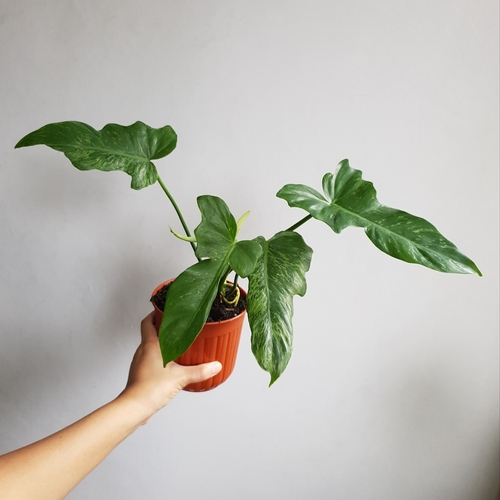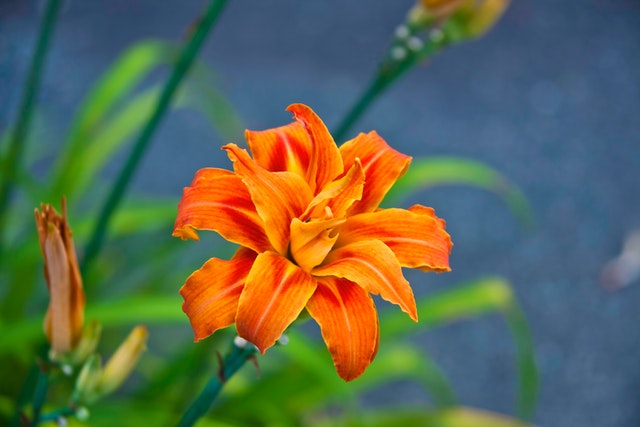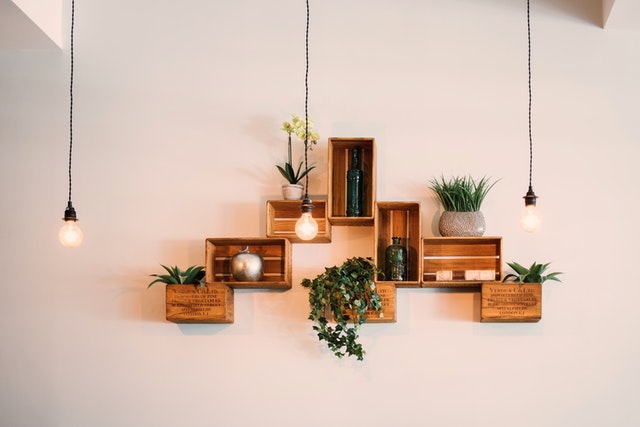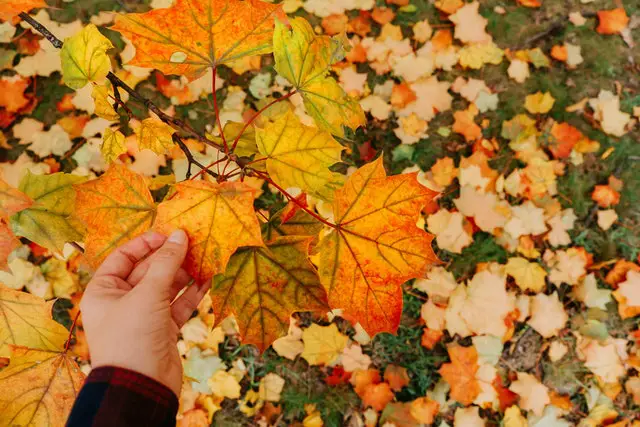Are you familiar with Philodendron Lime Fiddle? Maybe you have seen one but didn’t know the actual name. It is more notably known as ‘Philodendron Golden Dragon’. Such a mythical name comes from the appearance of the leaves that resembles a dragon. So, what’s the buzz about this plant?
Aside from its cool nickname, the Philodendron Lime Fiddle is meant to make the interior of a house cooler, both as a decoration and as an air purifier.
This indoor plant is quite expensive, which can be a potential income generator if invested in the business. So, if you are fascinated by owning one or growing one to sell, we better discuss it thoroughly. In this comprehensive grow and care guide, you will learn all about the Philodendron Lime Fiddle, from its ideal growing conditions to the best practices for ensuring a healthy and thriving plant.
What Is A Philodendron Lime Fiddle

Like all Philodendrons, the Philodendron Lime Fiddle is a tropical plant. The whole species come from the plant family Araceae. The Philodendron Lime Fiddle is now commonly used as an indoor plant not only because of its aesthetic appeal for the interior but also can be an air purifier.
The plant has large foliage that shapes like a mask. Yes, the leaves can cover a normal-sized face like masks do. And if you’re into fantasy books and films, you’ll find the resemblance to a dragon. The Philodendron Lime Fiddle, unlike most Philodendrons, is a fast grower. It can grow so large that it can measure 6 feet tall.
Most plant growers take advantage of its fast-growing pace. Due to the increase of enthusiasm for indoor plants during the height of the COVID-19 pandemic, there is a good market for Philodendrons. A functional decor and air purifier while being a fast grower?! No wonder the Philodendron Lime Fiddle can pique many people’s interests.
However, the plant is a bit expensive. Despite that, it can be considered a good investment since the care and propagation of Philodendron Lime Fiddle is relatively easy. Let’s learn more about that plant, starting from its origins.
Origin And Classification
The Philodendron Lime Fiddle is considered a hybrid plant. Although the exact origins remained questionable, it is believed to have come from Philodendron Bipennifolium Schott in Thailand. This type of Philodendron is a climber, meaning it can grow so long if it has some material to climb on as support such as a pole.
Features Of Philodendron Lime Fiddle
The most noticeable asset of the Philodendron Lime Fiddle is its foliage. That arrowhead-like shape, or dragon-like for fantasy lovers, can be pleasant to look at, especially when the plant matures. Though the leaves have no unusual pigments like the other Philodendrons, it still looks great for interior decorations.
1. Height
Philodendron Lime Fiddle is a climbing type of Philodendron. With ample care, the growth rate can be really fast. It can reach a maximum height of 6 feet and can expand up to 3 feet in width if not pruned. It can take up a considerable amount of space indoors.
If the Philodendron Lime Fiddle can’t achieve the maximum height due to a lack of material to climb on, it can be a semi-self-heading plant. This means that it will have a bushier appearance from having the stems grow thicker to keep the plant upright. You can have it either way since it will still fulfill its function.
2. Flowers & Leaves

The reason why the Philodendron Lime Fiddle is also called the ‘Golden Dragon’ is that its arrowhead-like leaves resemble that of a head of a dragon.
These leaves can become large green beauties with conspicuous, unusual pinnate lobes. On some Philodendron Lime Fiddles, the leaves can be goldenly mottled, hence the adjective ‘golden’ on its other nickname.
The variegations (or the diversity of colors on the leaves) for Philodendron Lime Fiddle occur because of natural cell mutations. This will result in a lack of production of chlorophyll in the affected areas. Therefore, the variegations can be unpredictable and unstable. A consequence of such is when the leaves’ colors are reverting.
3. Foliage & Stem
The Philodendron Lime Fiddle undergoes morphogenesis, just like most Philodendrons. This means that the immature Philodendron Lime Fiddle looks different from the fully-grown Philodendron Lime Fiddle.
The Philodendron Lime Fiddle, in its baby stage, has oblong-shaped leaves. They may have the signature golden splashes but more often they don’t.
As the plant enters the sub-adult stage, the posterior lobe of the newly grown leaves will gradually be slightly rounded while the anterior section will have shallowly lobed edges. When the plant matures, it will have larger, multi-lobed leaves and the leaf shape will look like an arrowhead or dragon’s head. Furthermore, the green pigment will have a gold mottling.
4. Evergreen
The Philodendron Lime Fiddles are herbaceous evergreens. They can grow whether placed indoors or outdoors. There are specific care requirements but compared to other indoor plants, the difficulty is minimal. It is said that the Philodendron Lime Fiddle can thrive in USDA zones 11 to 13, making it relatively easy to take care of and propagate under warm conditions.
Basic Care Of Philodendron Lime Fiddle
As frequently mentioned, the Philodendron Lime Fiddle is easy to handle due to its minimal requirements. Interested in what they are? Read the following requirements below.
1. Size & Growth
The Philodendron Lime Fiddle is usually a climber type. You need a totem, a moss pole, a trellis or a stake to provide the plant freedom to grow. It is important to secure such materials quickly since the plant is a fast-grower type. But remember, the Philodendron Lime Fiddle can also grow without those material aids, but it won’t reach its peak height.
2. Light Requirements

The light requirement for Philodendron Lime Fiddle, similar to most Philodendrons, is indirect bright light. This means you must not expose the plant to direct sunlight. However, if you have an enclosed room, you might need to provide grow lights since the plant needs enough illumination.
3. Water Requirements
Being a tropical plant, the Philodendron Lime Fiddle needs to be watered regularly. One simple way of knowing when to water is checking the topsoil, about 1 to 2 inches deep if it is moist or not. As much as you are concerned about underwatering, be careful also for overwatering.
4. Soil Requirements
The Philodendron Lime Fiddle needs good soil. It is already given that the soil must be chunky and full of organic matter. However, it must be well-drained since this plant needs moisture but not too much water. Try using this potting mix consisting of perlite, coco coir, peat moss, bark chips and compost.
5. Sunlight Requirements
It is already established that the Philodendron Lime Fiddle needs indirect bright light. Being exposed to direct sunlight is a no-no. But if you can’t avoid sun exposure due to having many windows, it is highly recommended to install curtains.
6. Temperature & Humidity
The recommended temperature level for Philodendron Lime Fiddle is from 65 to 85 degrees Fahrenheit. This means that it can thrive under the cold conditions of a room with an air conditioner and the normal room conditions.
On the other hand, the preferred humidity for this plant is 60 percent. If the growing space lacks humidity, you need a humidifier or use the pebble tray method.
7. Drought & Disease Resistance
The Philodendron Lime Fiddles are not drought resistant. They need a certain amount of moisture, not too little but not too much. However, they can be pest-resistant, as long as you use Neem oil for treatment.
8. Toxicity
Like most Philodendrons, the Philodendron Lime Fiddle is also toxic to humans and pets. This is due to the presence of Calcium Oxalate, which can induce vomiting and diarrhea in the ones ingesting the plant. Although the effects are not life-threatening, they can be fatal if left untreated.
9. Fertilizing
Once a month during the growing period, the Philodendron Lime Fiddle needs to be fertilized. Make sure to use a fertilizer that is balanced and in liquid form. You can also use the slow releasers.
10. Potting & Repotting

The maintenance for Philodendron Lime Fiddle is easy. You only need to repot the plant every 1 to 2 years on a container that has a diameter of 2 to 3 inches only. Do remember that this plant grows fast, and you need larger pots sooner than you think.
11. Pruning Requirements
The Philodendron Lime Fiddle needs little pruning. You can prune the plant once you noticed that there are diseased, damaged or dead leaves. Make sure to sterilize the gardening shears.
How To Propagate Philodendron Lime Fiddle
The Philodendron Lime Fiddle is easy to propagate. Due to the absence of seeds or pollens, the common ways to propagate this plant are through the use of stem cutting and air layering.
- Stem Cutting
- Step 1: Select a stem with 2 to 3 nodes wherein the knobby part has petiole or aerial roots attached. For variegated plants, select a stem node with a variegated leaf.
- Step 2: Use a pruning shear or knife to cut the stem below its node.
- Propagating In Water/Soil
For Propagation in Water
- Step 1: Apply a rooting hormone at the end of the cut. This is optional; nonetheless, it will prevent rot and speed rooting.
- Step 2: Choose a small, preferably transparent jar.
- Step 3: Fill it with distilled or clean water.
- Step 4: Place the stem cutting inside the jar. Make sure that it is submerged in water.
- Step 5: Position the jar where the cutting receives ample indirect sunlight.
- Step 6: Replace the water every 4 to 5 days, or if its appearance turns cloudy.
- Step 7: Around the 5th or 6th week, the roots will now be noticeable. Once it reaches a length beyond 2 inches, you can transplant it to a soil pot. Continue the growing process while following the care requirements stated above.
For Propagating in Soil

- Step 1: Apply a rooting hormone at the end of the cut. This is optional; nonetheless, it will prevent rot and speed rooting.
- Step 2: Choose a small, preferably transparent jar.
- Step 3: Apply an adequate amount of appropriate potting mix.
- Step 4: Place the cutting in the mixture.
- Step 5: Cover the pot with clear plastic and make sure it seals the moisture inside.
- Step 6: Position the pot under indirect sunlight.
- Step 7: Keep the soil moist.
- Step 8: If noticeable roots are growing, you can now transplant them to another pot and continue growing.
- Air Layering
- Step 1: Cover a node with a damp sphagnum moss without detaching from the main plant.
- Step 2: Make sure the sphagnum moss is aerated and moist.
- Step 3: As the node is rooting, if the root is long enough, only then you can cut it and place it in its growing pot.
Common Problems In Caring For Philodendron Lime Fiddle
When caring for Philodendron Lime Fiddle, you can come across problems. Although they are not that alarming, if you neglect the signs, then you can expect a headache later on. Let’s see the common problems you might encounter.
1. Pests
The Philodendron Lime Fiddle may be fairly pest-resistant, but it cannot avoid the presence of some annoying creatures. These include thrips, mites, scale insects, mealybugs and aphids. Fortunately, they can be easily plucked. They can be further avoided through spraying of Neem oil around the stems and foliage.
2. Overwatering
Overwatering any Philodendron can cause root rot. Sometimes, it can be unavoidable to overwater. That is why the plant’s soil is the key to countering that. Remember to put a well-drained soil. Add some drainage also if needed. For damaged roots, cut them off immediately and repot the Philodendron.
3. Leaf Discoloration

Leaf discoloration is when the leaves turn yellow, black or brown, including the edges and tips. This is caused by improper care, either doing too little or doing too much. Cut off the discolored leaves and regulate your care procedures.
Learn more from a related post: Philodendron Golden Crocodile
Conclusion
The Philodendron Lime Fiddle, or Golden Dragon, is a great indoor plant that doesn’t disappoint as a decoration. Its oddly shaped leaves can surely capture anyone’s interest and it is made even better with its air-purifying capabilities. Although it can be rare and expensive, being a plant that is easy to maintain makes it a good investment.
If you’re looking to purchase one, many online shops are selling legitimate Philodendron Lime Fiddle. You can start looking at Etsy where the price of one can range from $35 to $150. For the variegated ones, it can cost more than $1600.
Frequently Asked Questions
Is Lime Fiddle the same as Golden Dragon?
The Philodendron Lime Fiddle is also known as Philodendron Golden Dragon. A few sources have disputed that the 2 are not the same, but the majority confirmed that they truly are. It all lies in its appearance. For your information, the Philodendron Lime Fiddle has many nicknames too, depending on which country you reside.
Is Philodendron Golden Dragon a hybrid?
Yes, the Philodendron Lime Fiddle or Philodendron Golden Dragon is a hybrid from Thailand.
The origin is disputable, but many believe that its source is the Philodendron Bipennifolium Schott. Like most Philodendrons, the Philodendron Lime Fiddle is rare but easy to propagate.
Can my variegated Philodendron Lime Fiddle revert?
Because of natural cell mutations, the Philodendron Lime Fiddle can have variegations. For the same reason, those variegations can sometimes cause the plant to revert its colors to purely green. It will depend on the environment or sometimes on sheer luck.

Hey, I’m Lisa and I’ve been an avid gardener for over 30 years. I love writing, talking and living in the garden! Feel free to connect with me on my socials below
